Announcing the 2025 GM on Main Street Grant Recipients
Meet the recipients of the 2025 GM on Main Street grants!

Marion, Iowa © Tasha Sams
We work in collaboration with thousands of local partners and grassroots leaders across the nation who share our commitment to advancing shared prosperity, creating resilient economies, and improving quality of life.

Emporia, Kansas © Emporia Main Street
Made up of small towns, mid-sized communities, and urban commercial districts, the thousands of organizations, individuals, volunteers, and local leaders that make up Main Street America™ represent the broad diversity that makes this country so unique.

Chicago, Illinois © Main Street America
Looking for strategies and tools to support you in your work? Delve into the Main Street Resource Center and explore a wide range of resources including our extensive Knowledge Hub, professional development opportunities, field service offerings, advocacy support, and more!

Waterloo, Iowa © Main Street Waterloo
Your one-stop-shop for all the latest stories, news, events, and opportunities – including grants and funding programs – across Main Street.

Kendall Whittier — Tulsa, Oklahoma © Kendall Whittier Main Street
Join us in our work to advance shared prosperity, create strong economies, and improve quality of life in downtowns and neighborhood commercial districts.

This article was published in the Fall 2020 edition of the Economic Development Journal, a publication available to members of the International Economic Development Council, and is being reprinted with its permission. To have access to IEDC's Journal articles and its many services, you can become a member by visiting https://www.iedconline.org.
Local community economic development organizations rely on both public and private sources of funding to support their work. Yet, it has been increasingly difficult to secure the amount needed from public sources. Reductions in grant funding at the federal, state, and local levels of government, including programs like the Community Development Block Grant (CDBG), the Home Investment Partnerships Program, and the Neighborhood Stabilization Program make it even more difficult for locally-based organizations to heavily rely on government support. Data from the Community Development Block Grant Coalition lists several examples to demonstrate the incremental cuts since the program’s inception. For example, the CDBG allocation in Miami-Dade County, Florida, in 2019 was only half of what it was in 1975, and Huntsville, Alabama’s CDBG allocation dropped nearly 75 percent from 1975 to 2019, from $4 million to $1.3 million.
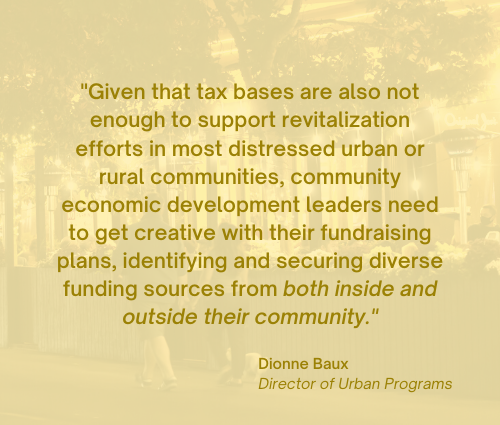
The past two federal budget cycles for the Housing and Urban Development (HUD) Capacity Building for Community Development “Section 4” program has been up for deeply proposed cuts as well. Section 4 grants are awarded to intermediaries that re-grant to community development corporations (CDCs) to use funds for specific investments, including affordable housing and economic development.
Given that tax bases are also not enough to support revitalization efforts in most distressed urban or rural communities, community economic development leaders need to get creative with their fundraising plans, identifying and securing diverse funding sources from both inside and outside their community. These additional funding sources will be crucial to moving local economic development planning efforts forward, including small business technical assistance, recruitment, incentive programs, and staff support to lead on-the-ground efforts. While there is no one-size-fits-all fundraising approach that will work for every economic development group, one thing is for certain: Local groups that develop relationships with local, state, and national foundations to support revitalization efforts on the ground are better positioned for success.
This article provides an overview of foundations and philanthropy trends, offers insight into the programs and initiatives that foundations are launching to ensure that more people have access to grant funding, and explores the ways in which Main Street America (MSA) and UrbanMain (UM) are helping to connect communities and foundations to ensure more communities can benefit from this crucial funding source.
Jump to: Types of Philanthropic Foundations | Philanthropy Giving Trends | Increasing Access to Foundation Funding | COVID-19 Giving | Bridging the Gap | Next Steps
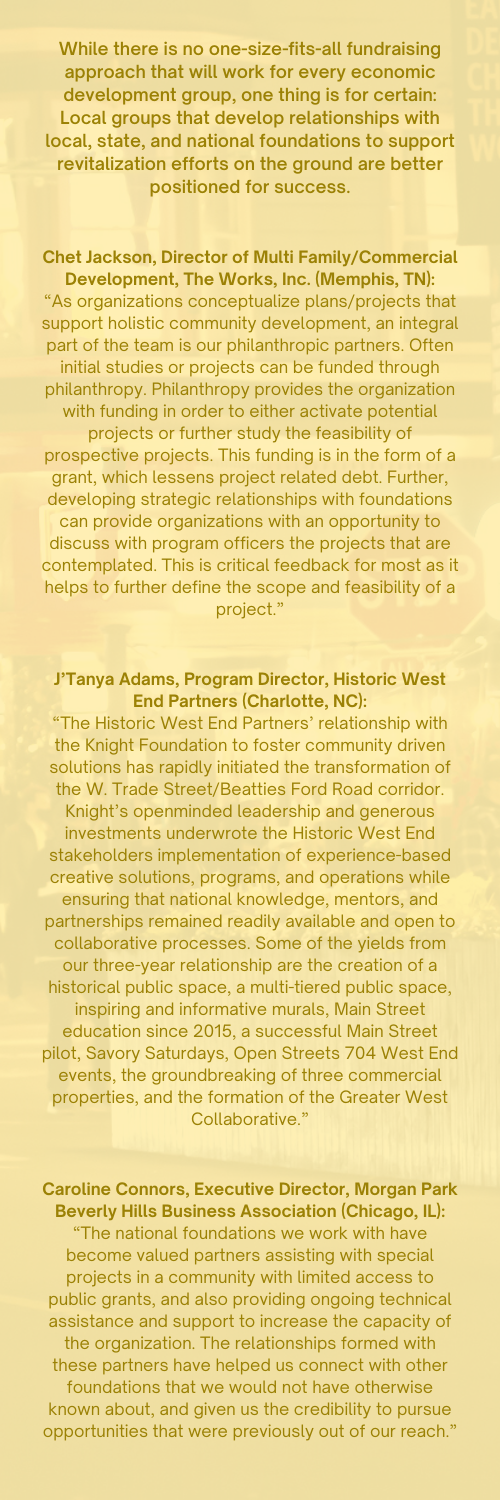
The Council on Foundations defines a foundation as an entity that supports charitable activities by making grants to unrelated organizations, institutions, or to individuals for scientific, educational, cultural, religious or other charitable activities or programs. Traditionally most foundations are engaged in grantmaking activities, and in some cases, they may engage in their own direct charitable activities or programs. Organizations that only operate charitable activities are classified under Section 501 (c) (3) of the Internal Revenue Code and must adhere to the following legal characteristics:
Following are some of the most common types of foundations:
As the Council on Foundations notes, most of the terms listed above are not legal classifications but are descriptive terms used within the field of philanthropy to help grantees, partners, and others to understand how the foundation operates. A commonality of each of these foundations is that they were established to assist community and economic development, educational, religious, or other charitable needs. Most foundations have a governance structure including a board of directors that makes discretionary giving decisions, often within the foundation’s priority areas or field of interest and/or geographic area.
Back to top.
The National Center for Charitable Statistics is a data portal designed for nonprofit practitioners, researchers, and policy makers. Its 2019 Nonprofit Sector in Brief discusses trends in the finances of 501(c)(3) public charities and key data insights on important resources for the nonprofit sector, such as private charitable contributions and grantmaking by foundations.
According to the brief, The Foundation Center estimates there were more than 86,125 grantmaking foundations in the United States in 2017. Their grants totaled $77.7 billion in 2017, up 10.4 percent from 2016 after adjusting for inflation. This amounts to approximately 18 percent of private charitable contributions that year. While foundation grants dipped slightly in 2018, they have been on an upward trajectory for years – the amount of grants distributed grew 70 percent from 2005 to 2017 after adjusting for inflation.
The following shows how foundation giving compares to other types of giving as well as where funds are going. It is important for economic development practitioners to understand the trends of foundation giving and the types of projects being supported.

Giving by Source1:
Giving by Use1:
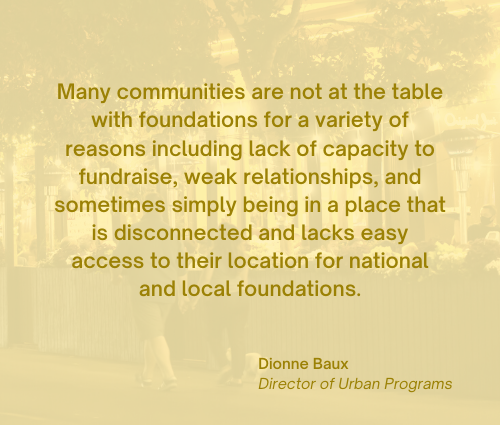
Many communities are not at the table with foundations for a variety of reasons including lack of capacity to fundraise, weak relationships, and sometimes simply being in a place that is disconnected and lacks easy access to their location for national and local foundations. Several national foundations such at Kresge, Ford, and MacArthur Foundations have created national initiatives to expand their reach in more rural and urban communities that have lacked access to financial opportunity and have begun reaching out directly to intermediaries, communities, and city governments to develop funding relationships.
Examples include:
By no means is this an exhaustive list of national funders and initiatives. Foundations such as the Bill and Melinda Gates Foundation, Rockefeller Foundation, and a host of others each offer national and international initiatives to aid and uplift those that have been left behind.
Back to top.
The onset of the novel Corona 19 virus has created a global health and economic crisis that has negatively impacted gains for community-based organizations leading economic development and their businesses. The need for economic development practitioners to foster relationships with foundations is ever-more pressing today amidst the pandemic. According to Candid’s article, “Record-Breaking COVID-19 Philanthropy Topped Giving for Other Disasters but Overlooked Those Most Affected by the Pandemic,” the data shows that foundations, public charities, corporations, and individual donors immediately responded to the needs and services arising from the pandemic; however, only 5 percent of $11.9 billion in total funding was explicitly directed to communities and persons of color, which have been hardest hit by COVID-19.2
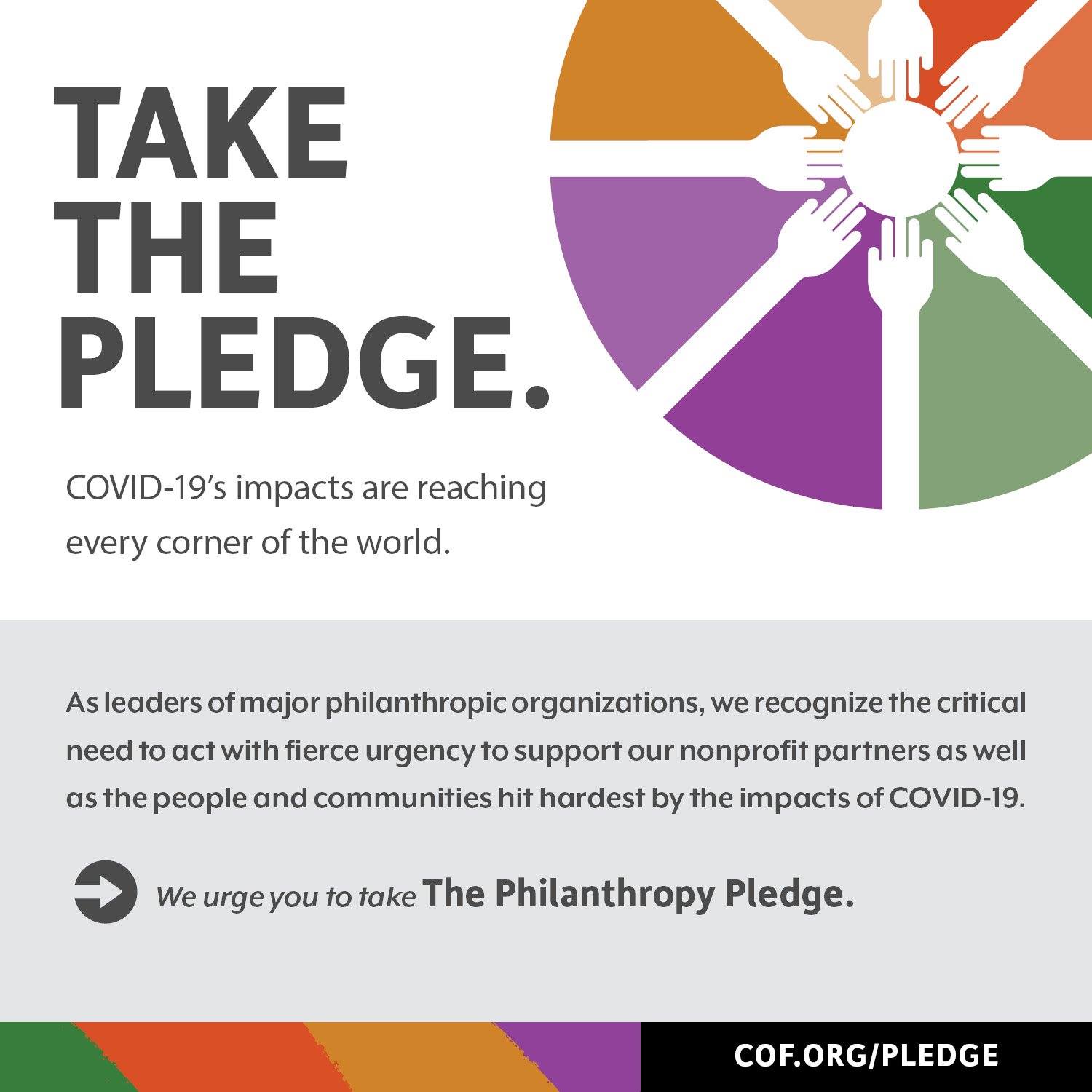
The Council on Foundations in response to the havoc COVID-19 is creating for their nonprofit partners has invited their funders and other leaders in the philanthropic sector to join a call for action by signing a pledge of action (pictured right) to the following3:
While foundations are doing great work at extending their reach, there is still work to be done to connect communities with foundation resources to support economic development. Recognizing the need to help bridge the gap, Main Street America has been working to develop relationships with both national and local foundations that have supported community economic development over the past several years. With their help, we then connect and partner with community groups to provide capacity building and technical support required to effectively lead commercial district revitalization work.

For example, a few years ago we developed a relationship with the James L. Knight Foundation, a national funder dedicated to fostering “informed and engaged communities” with a special focus in 26 communities. With their support, we conducted a multi-city approach to refine, test, and introduce seven new communities to Main Street America’s signature economic development framework. The seven pilot sites included: Detroit, Michigan; Biloxi, Mississippi; Gary, Indiana; Lexington, Kentucky; Miami, Florida; Milledgeville, Georgia; and Philadelphia, Pennsylvania.
The Knight Foundation’s support enabled communities to deepen its engagement with their local resident and business community in every step of the process. MSA and its partners used market information including demographic data, trends, sales leakage and surplus, business investors and cluster analysis as one tool to help illuminate the best revitalization path forward. We also distributed a public and leadership survey in each city to identify challenges, opportunities, attitudes and impressions of the commercial district. Along with tours and interviews, this process was integral to developing a focused, deliberate path to revitalizing the commercial district – what MSA refers to as a Transformation Strategy.
MSA has also partnered with foundations to garner local support for community groups through state and regional collaborations. In 2019, Main Street America partnered with PNC Foundation, Marion Ewing Kauffman Foundation, and The Anne T. and Robert M. Bass Center for Transformative Placemaking to develop and sustain new entrepreneurial growth in three Appalachian Ohio communities.
The program components include:
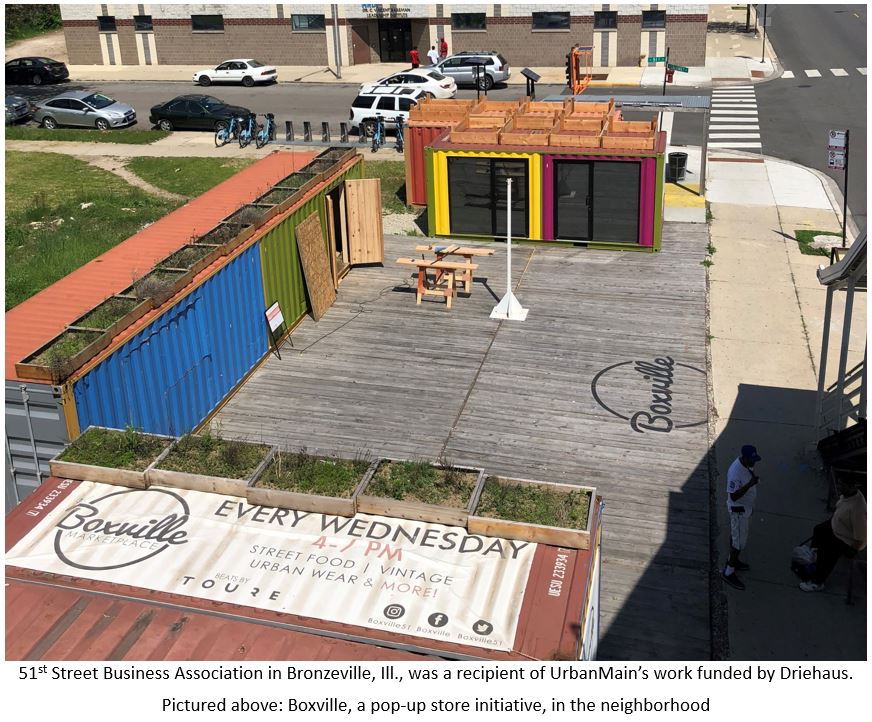
Finally, local foundations generally serve as a good starting place for local community economic development entities. In Chicago, Main Street America engaged with the Richard H. Driehaus Foundation to support local revitalization work. The foundation focuses on four program areas: built environment, arts and culture, investigative journalism for government accountability, and economic opportunity for the working poor. Driehaus’ support enabled UrbanMain to work with two Chicago neighborhood commercial corridors groups and explore implementing Main Street’s signature economic development approach to corridor revitalization.
The 51st Street Business Association and South Shore Chamber of Commerce each received the following set of services:
Philanthropic support is a major ingredient to support long-term sustainable investment in economic development and is often the dollars needed to take a project over the finish line. It is crucial for local economic development organizations and staff to broaden relationships with local, state, and national foundations. Fundraising plans are a great strategy but “good-old fashioned” relationship building is at the crux of this work.
According to the Starfish Impact article “The Non-Profit Guide to Building Relationships with Foundations,” key steps that a local group should always consider when beginning to embark on building relationships with foundations include:
First spend time getting to know your local program officers, (absent COVID-19) through quick 1:1 conversations to learn more about the foundation priorities and how their priorities may align with the work your organization is leading.
Respect the program officer’s time and don’t take too much of their time. These folks are receiving constant requests from many organizations like yours, so be respectful.
Never make an ask in the first meeting. You are getting to know each other by building a working relationship.
Research, research, research. Learn more about the foundation you are approaching before you sit down with them. Do your homework!
See and be seen. Go to the networking events that your local foundations are hosting and participate in requests for proposal sessions. Let them know you are there and interested in getting to know them.
Invite the program officer or local foundation to your community to visit your corridor, meet with your board, and ask local constituents to share the great work you’ve completed to date.
Be proactive. Initiate your local foundation in a dialogue; don’t be a passive responder to a request. Share your good news and the work you have accomplished.
Do not add your foundation partners to your general newsletter lists; communicate with them individually and be intentional about your outreach. Remember your local foundations are being inundated with requests and communication.
Finally, once you’ve applied to the grant application and are approved, make sure to provide timely grant reports and updates to your foundation partners on your progression.
1. https://givingusa.org/giving-u...
2. https://candid.org/about/press...
3. https://www.cof.org/news/call-...